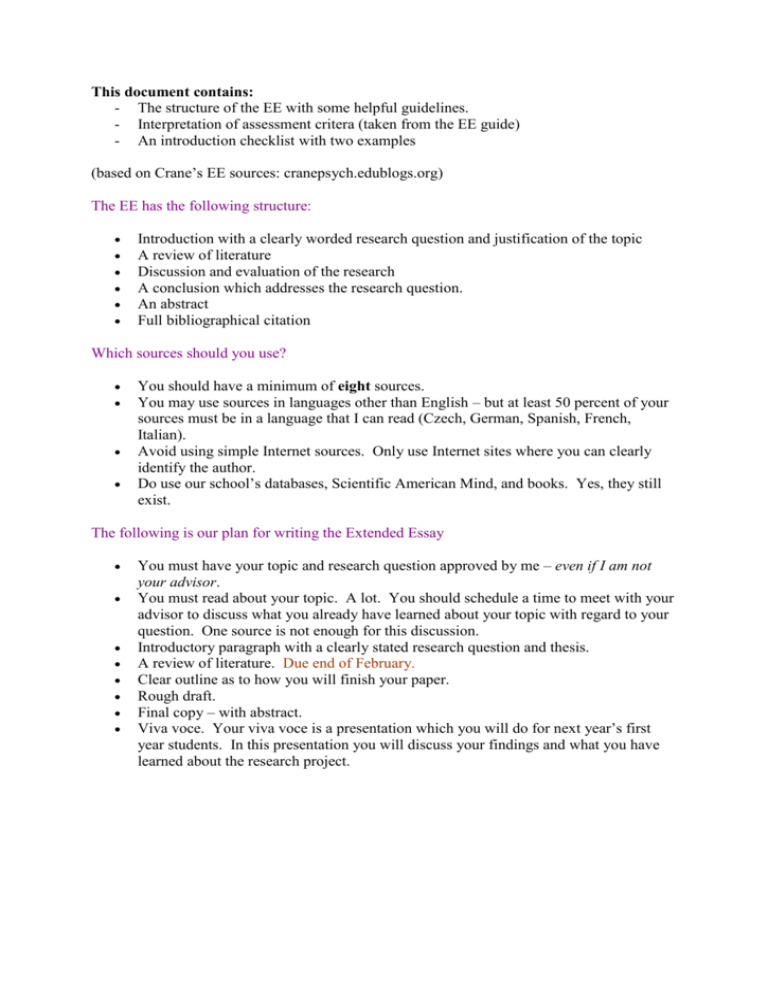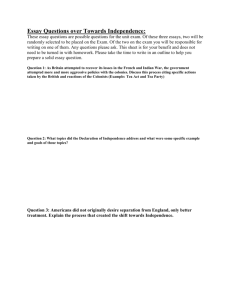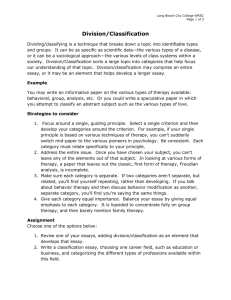Interpreting the Extended Essay assessment criteria
advertisement

This document contains: - The structure of the EE with some helpful guidelines. - Interpretation of assessment critera (taken from the EE guide) - An introduction checklist with two examples (based on Crane’s EE sources: cranepsych.edublogs.org) The EE has the following structure: Introduction with a clearly worded research question and justification of the topic A review of literature Discussion and evaluation of the research A conclusion which addresses the research question. An abstract Full bibliographical citation Which sources should you use? You should have a minimum of eight sources. You may use sources in languages other than English – but at least 50 percent of your sources must be in a language that I can read (Czech, German, Spanish, French, Italian). Avoid using simple Internet sources. Only use Internet sites where you can clearly identify the author. Do use our school’s databases, Scientific American Mind, and books. Yes, they still exist. The following is our plan for writing the Extended Essay You must have your topic and research question approved by me – even if I am not your advisor. You must read about your topic. A lot. You should schedule a time to meet with your advisor to discuss what you already have learned about your topic with regard to your question. One source is not enough for this discussion. Introductory paragraph with a clearly stated research question and thesis. A review of literature. Due end of February. Clear outline as to how you will finish your paper. Rough draft. Final copy – with abstract. Viva voce. Your viva voce is a presentation which you will do for next year’s first year students. In this presentation you will discuss your findings and what you have learned about the research project. Interpreting the Extended Essay assessment criteria Criterion A: research question The research question may be written in the form of a question, proposition or statement. It should be focused on a topic that is clearly relevant to psychology, deals with behaviour and is able to be addressed consistently throughout the extended essay. Criterion B: introduction This section should place the research question in the context of existing knowledge and understanding of the topic. The student’s personal experience or views should not appear in this section. Previous psychological studies that can be related to the research question should be considered. The studies that are introduced here may be generally supportive but they are unlikely to answer the research question in an entirely satisfactory manner. It is part of the student’s task to identify strengths, weaknesses and omissions of past work, and to show how his or her essay could help to resolve some of the problems that have been identified. Criterion C: investigation There is a wide range of resources available for questions that are likely to be raised in extended essays related to psychology. These include textbooks, academic journals, films, television, radio, newspapers and Internet-based sources. Film, television, radio, newspapers and Internet-based sources should be treated with considerable caution since the material they contain may be neither accurate nor valid. The essay should present findings and theories from these sources in an evaluative context and students should not necessarily accept their findings at face value. A healthy but informed scepticism should be maintained towards material from film, television, radio, newspapers and Internet-based sources, until authoritative judgment allows their findings or theories to become accepted. Although the argument presented in the essay may be supported by limited data gathered by the student, the presentation or analysis of such material should be used for illustrative purposes only and should form only a very minor part of the evidence used. Criterion D: knowledge and understanding of the topic studied Evidence and findings from empirical studies and their related theories should be an integral part of extended essays for psychology. Such material may refer to human or non-human animals and their associated behaviours. Where appropriate, students should draw on cultural, ethical, gender and methodological considerations; they should show how these aspects may affect the interpretation of the question that is the focus of the essay. Criterion E: reasoned argument The research question should be the central focus of the argument as it is developed throughout the essay. As the argument is constructed it often creates conflict between varying theories and findings from studies. The student should explain and analyse these different views and marshal those essential points that support the argument that is being advanced. It is the task of the student to persuade the reader of the reasons for and validity of his or her view. This is best accomplished by using a logical approach where successive salient points are built up, one upon the other. Criterion F: application of analytical and evaluative skills appropriate to the subject Demanding cognitive effort is needed to apply analytical and evaluative factors created by the student. The analysis and evaluation need to be covered in depth since these will lead to the crux of the argument. There is also an opportunity for the student to use reflexivity—a consideration of his or her own experiences and views that have contributed to the methods used in the investigation and the interpretation of points that have arisen. Criterion G: use of language appropriate to the subject Psychology is a subject that uses its terminology in a specific manner, and students are expected to use this in their essays. Students who have not studied psychology as a specific part of an academic course are strongly urged to become thoroughly acquainted with the language used by psychologists and how it is applied within the discipline. Criterion H: conclusion The conclusion is a synthesis of the argument that has preceded it. It is the end point of a logical process that has been established by employing a succession of psychological studies and theories to justify the case that has been presented. Criterion I: formal presentation This criterion relates to the extent to which essays conform to academic standards about the way in which research papers should be presented. The presentation of essays that omit a bibliography or that do not give references for quotations is deemed unacceptable (level 1). Essays that omit one of the required elements—title page, table of contents, page numbers— are deemed no better than satisfactory (maximum level 2), while essays that omit two of them are deemed poor at best (maximum level 1). Criterion J: abstract The abstract is judged on the clarity with which it presents an overview of the research and the essay, not on the quality of the research question itself, nor on the quality of argument or the conclusions. Criterion K: holistic judgment Qualities that are rewarded under this criterion include intellectual initiative, insight, and breadth and depth of understanding. Ways of demonstrating such qualities include: • choice of a relevant research question that extends the student’s thinking but is also feasible within the time available • location and judicious use of resources • analysis and evaluation of psychological material to produce salient points for the argument • use of a reflexive approach that involves the views and imagination of the student to make a unique contribution to understanding the topic. Introduction checklist Does your introduction include the following? Yes No An indication why the topic chosen is interesting, important or worthy of study Some background information and an attempt to place the topic in an appropriate context An indication of whether the topic has been narrowed to a focus of more manageable proportions A clearly and precisely stated research question A clear concluding statement of the thesis and the response to the research question that will subsequently be developed in the body of the essay Sample introduction 1: the research question is in boldface print. The concept of “road rage” is relatively new.1 It was only in the 1990s that the media began to focus on road rage incidents, leading some commentators to argue that road rage is a media invention and not a real phenomenon. Other researchers dispute this, however, arguing that the term “road rage” is simply a new label for criminal, aggressive or anti‐social behaviour on the road that is a widely recognised problem and the cause of many accidents. Road rage at its most serious can lead to physical attacks, but it is more often manifested in aggressive driving or verbal abuse. Surveys suggest that most drivers have experienced some form of road rage, as victim or as perpetrator. For example, the British Crime Survey based on a random sample in 1998 found that over half of all drivers questioned said they had been the victim of some form of road rage ranging from verbal abuse or gestures to being forced off the road or threatened with violence (Marshall and Thomas, 2000). According to one researcher, aggressive driving and road rage worldwide cause hundreds of thousands of deaths every year and damage worth billions of dollars (McDonald, 2002, p.1). Moreover, the problem is set to increase as more people use vehicles to travel and roads become more congested. Many countries, including the United States, the United Kingdom, Canada and China, have acknowledged the problem of road rage and some have taken measures to help prevent dangerous driving and road rage incidents. Ten years ago the head of the US National Highway Traffic Safety Administration declared that road rage had become the number one traffic problem (James, 1997a). This essay will examine psychological explanations of road rage and how they can help in designing measures to reduce the problem and so cut the number of accidents. It concludes that policies that aim to change or affect driver psychology can be useful, but policies to reduce external causes of stress are also needed. Sample introduction 2:the research question is in boldface print. The mind and body relationship is an issue that has been acknowledged since ancient times. The mind-brain problem poses the question of whether the mind is no more than a nuisance to our brain processes or whether the mind can, to some extent, influences our behaviour. ‘Dualism’ is the approach in psychology, which stresses the mind and body as being two existing and interconnected entities. According to one of the first dualists, Descartes, the mind influences the body and not vice versa1, whereas the ‘interactionists’ claimed that both the mind and body have influence on one another. Hence, by the means of applying the interactionist point of view, the psychophysiological correlates of stress and illness can be studied. How psychological factors such as stress can lead to psychophysiological effects has been and will continue to be a fundamental topic of research in psychology. It is interesting to investigate the issue of stress and its causes and effects on humans, since stress is copious in our modern society. Therefore this essay intends to deal with following research question: What do we know about the relationship between stress and physiological illness and can we use that knowledge to cope with stress? Stress, according to physicists, stress would simply be defined as ‘the pressure or force that is exerted to a body.2’ However, according to psychologists, stress is a more complex factor, which is looked upon in terms of ‘the demands it possesses on an organism and how the organism attempts to adapt or cope with the specific demands’3. A definition of stress that has been widely accepted was established by Lazarus and Folkman (1984). According to these researchers, stress is ‘a pattern of negative physiological states and psychological responses occurring in situations where individuals perceive threats to their well-being, which they may be unable to meet.’ 4 Whether stressors are harmful or not depends solely on individuals appraise the stressors and how the mind interprets them (Lazarus, 1975). It would seem appropriate here to define what is meant by physiological illness. Illness itself is a broad concept, but in general it refers to problems and challenges to the health and wellbeing of humans5. A physiological illness is any illness in which physical symptoms are assumed to be the direct result of psychological or physical factors6. Eminent studies conducted by Friedman and Rosenheim (1974), Sweeney (1995) and Cohen et al. (1996) focusing on the relationships between stress and its influence on the weakening of the immune system and on cardiovascular disorders, have led psychologists to establish the concept that there is a clear relationship between stress and physiological illness. Furthermore, studies that measure the efficacy of the methods to cope with stress, as such performed by Holmes and Rahe (1978) and Jacob et al. (1977) have also presented support for the view that, specific coping methods such as: social support, biofeedback, meditation and anti-stress drugs, can reduce the effects of stress and thus prevent physiological disorders. To determine what we know about the relationship between stress and physiological illness and whether we can use that knowledge to cope with stress, it is firstly important to outline the causes of stress, which include life changes, frustrations, hassles and uplifts of everyday life. Subsequently, the reactions to stress, which encompass both physiological and psychological features, should be explained, since evidence has shown that they lead to physiological illness. Furthermore, in order to counterbalance stress, there are specific coping methods have been suggested and these methods are devised by the means of using the knowledge that is obtained about the stressors and their effects.









